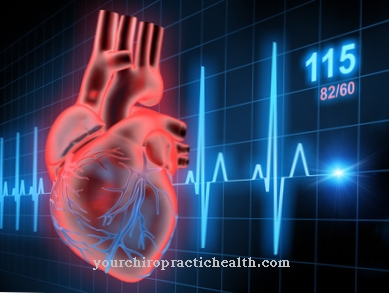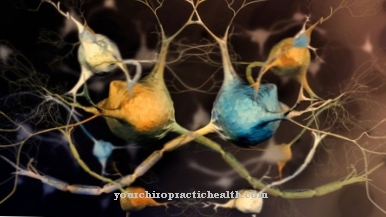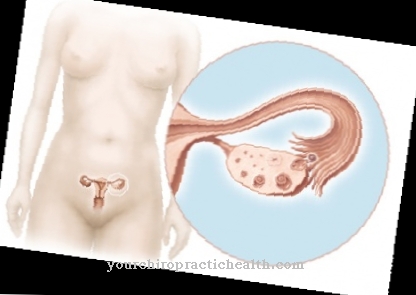Of the Fat loss, also called lipolysis, takes place mainly in the fat cells (adipocytes). The most important function of lipolysis is to generate energy. But there are also disturbing influences that inhibit fat loss.
What is Fat Loss?

The breakdown of fat in the body is also known as lipolysis. The breakdown of fat begins in the stomach, where only about 15 percent of the fat is broken down into so-called monoacylglycerides. Most of it is then converted into monoglycerides in the intestine.
Lipases are responsible for splitting fat. Together with long-chain fatty acids, the monoesters then form so-called micelles. These micelles passively diffuse through the cell membranes into the intestinal mucosa. There they are converted back into fats and bound together with cholesterol, phospholipids and lipoproteins to form chylomicrons.
The chylomicrons are considered to be the actual form of transport of lipids in the blood, which also includes fats. They are mainly transported with the blood to the fat cells (adipocytes) and to a small extent also to the muscle cells and the liver. The actual lipolysis then takes place in the adipocytes.
Function & task
The breakdown of fat in the fat cells is the most important source of energy for animals and humans. In evolution, this form of energy storage has proven to be very effective. In times of excess food, more calories were consumed than consumed in order to then store the excess energy in the form of fat in adipose tissue. In times of food shortages, the body could then fall back on these reserves.
Since there is a constant abundance of food in industrialized countries, many people today gain more fat than lose it. The result is an increased storage of body fat. The adipocytes are increasingly enriched with fats.
Nonetheless, fat is constantly being broken down in adipose tissue, because even heavily filled adipose tissue must constantly supply the body with energy. But when the energy requirement is lower, lipolysis is not sufficient to establish a balance with lipogenesis (fatty acid synthesis).
Lipolysis in adipose tissue takes place in three steps. First, the enzyme adipocyte triglyceride lipase (ATGL) splits off a fatty acid, leaving a diglyceride. In a second step, this diglyceride is again subject to a breakdown of fatty acids by means of hormone-sensitive lipase (HSL). The resulting monoglyceride is then split into a fatty acid molecule and glycerine by the monoglyceride lipase (MGL). Fatty acids and glycerine molecules are transported to their target organs via the blood, where they are converted into simpler compounds such as carbon dioxide, water and ketone bodies while generating energy.
The breakdown of fat in the adipocytes is controlled by hormones. Certain hormones such as adrenaline, noradrenaline, glucagon, ACTH, cortisol, growth hormone and thyroid hormones activate lipolysis.
Other hormones, however, inhibit fat loss. These include insulin and prostaglandin E1. Nicotinic acid and beta-blockers also have an inhibitory effect on lipolysis. The hormonal regulatory mechanisms for fat loss are derived from the nutritional status of the organism.
Illnesses & ailments
The disturbed balance between fat build-up and fat breakdown is taking on pathological features in industrialized countries today. Obesity has now become a widespread disease. Many degenerative diseases can arise from obesity.
First, there has been a significant increase in type II diabetes. As part of the metabolic syndrome, in addition to diabetes, arteriosclerosis, lipid metabolism disorders and cardiovascular diseases can also develop. In addition, the number of diseases such as arthritis, arthrosis and rheumatism is also increasing. Overweight was also found to be linked to certain cancers.
Of course, it has long been known that breaking down excess fat can reverse many diseases. For example, type II diabetes can be stopped in the initial phase through fat loss through a change in diet and plenty of exercise. Diseases of the cardiovascular system also have more positive prognoses when overweight is reduced.
The main requirement for a healthier life is the reduction of excess weight by changing the previous way of life. However, sometimes this path is not that easy. There are also diseases and physical imbalances that prevent the normal breakdown of body fat.
If the thyroid is underactive, it is very difficult to lose weight because the thyroid hormone to activate the metabolism is insufficient. This greatly reduces the basal metabolic rate. The body uses too little energy.
Other hormonal imbalances can also inhibit fat loss. Cortisol activates lipolysis. But it also increases the breakdown of the body's own proteins into glucose, which is then converted into fat. In addition, the muscle breakdown also leads to a reduction in the basal metabolic rate. As a result, a trunk obesity develops with a characteristic fat distribution.
Lipogenesis is also promoted and lipolysis inhibited when there is a lack of testosterone or high estrogen levels. Furthermore, it was found that food allergies, due to permanent inflammatory reactions, release substances that make fat breakdown more difficult.
In recent years, the dependence of body weight on the intestinal flora has also been recognized. Overweight people have an intestinal flora that probably produces substances that inhibit fat breakdown.
Certain medications can also make weight loss difficult. These drugs include blood sugar and cholesterol lowering drugs, beta blockers, drugs containing cortisol, antidepressants, neuroleptics or the pill. Flavor enhancers such as glutamate can paralyze the feeling of fullness.
It was also found that sweeteners can trigger food cravings. On the one hand, fat loss has a great effect on physical health and, on the other hand, is influenced by various activating or inhibiting factors.






.jpg)

















.jpg)



